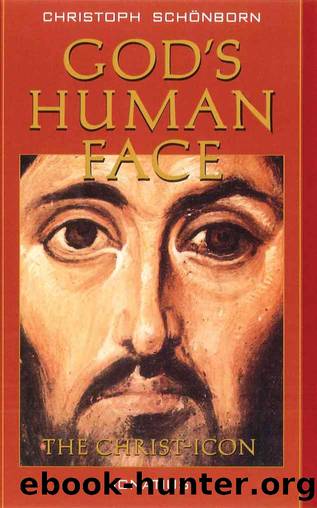God's Human Face by Cardinal Christoph Schoenborn

Author:Cardinal Christoph Schoenborn [Schoenborn, Cardinal Christoph]
Language: eng
Format: epub
Tags: Spiritual & Religion
ISBN: 9781681492124
Publisher: Ignatius Press
Published: 2011-04-01T06:00:00+00:00
6. âImage and Symbol of Himselfâ
This interchange between God and man was in a special way made visible at Christâs Transfiguration. The Transfiguration on Mount Tabor lets us sense the ultimate purpose of the Incarnation:
In his outward appearance he was like us; for in his boundless love he took it upon himself to become creature, yet without changing [his divinity], and thus he became the image [typos] and symbol of himself: he has revealed himself symbolically out of his inner being; through himself who is visible he has drawn the whole of creation to himself who is invisible and totally hidden.229
This dense text, formulated with the precision of the Greek language, represents in a sense a summary of all that Maximus taught concerning our topic. Closing this chapter, we can let ourselves be guided by this text, in order to recapitulate the results and to compare them with the previous stages of our journey so far.
At first sight, this text brings to mind Origenâs view of the Incarnation; Christâs humanity is the indispensable medium that God had to employ in order to reveal himself to us men who are bound by the realm of the senses; the intention, however, remained always to reach beyond the instrument of the human form and to arrive at the invisible, hidden divinity of the Logos. On Mount Tabor, in Christâs Transfiguration, does not the divine glory for a brief moment break through the obscure veil of the flesh? Yet what precisely did Maximus say? That Christ âhas revealed himself symbolically out of his inner beingâ. The emphasis focuses entirely on âhimselfâ. In his humanity, he has shown nothing else but âhimselfâ. âHe himself who is visibleâ is no other than âhe himself who is invisible and totally hiddenâ. The path from one to the other does not lead anywhere but to him himself; this path never leaves its starting point, for the Lord himself is this path. Christâs humanity, âhe who is visibleâ, is the image and symbol, not of someone other and different in his invisibility, but of âhim himself who is invisibleâ. The two sides, the one visible and the other invisible, can never be separated; for both pertain to the one Lord.
The visible side, the human likeness of Jesus, is irrevocably the âimage and symbolâ of the Son of God. The Word became flesh, and remains so. But where does it direct us? To âhimself who is hiddenâ. The Word would guide us âfrom himself to himselfâ, and this journey, this transition, is indeed the âpaschal passageâ of the Lord, that âexodusâ about which Christ conversed with Moses and Elijah at the Transfiguration (cf. Lk 9:31). In his paschal passage, Christ leads âall of creationâ to the Father; for he, once lifted up from the earth, draws all to himself (Jn 12:32). He himself is the way to the Father; to find him means to have already reached the Father. There is no other access to Godâs glory than the face of Christ (2 Cor 4:6).
Download
This site does not store any files on its server. We only index and link to content provided by other sites. Please contact the content providers to delete copyright contents if any and email us, we'll remove relevant links or contents immediately.
Never by Ken Follett(2896)
The Man Who Died Twice by Richard Osman(2302)
Machine Learning at Scale with H2O by Gregory Keys | David Whiting(2299)
Fairy Tale by Stephen King(2078)
Will by Will Smith(2047)
Reminders of Him: A Novel by Colleen Hoover(1886)
Rationality by Steven Pinker(1769)
The Stranger in the Lifeboat by Mitch Albom(1535)
New Morning Mercies: A Daily Gospel Devotional by Paul David Tripp(1346)
Friends, Lovers, and the Big Terrible Thing by Matthew Perry(1336)
The Becoming by Nora Roberts(1332)
A Short History of War by Jeremy Black(1302)
The Strength In Our Scars by Bianca Sparacino(1260)
HBR's 10 Must Reads 2022 by Harvard Business Review(1257)
The Fall of Babel by Josiah Bancroft(1238)
Can't Hurt Me: Master Your Mind and Defy the Odds - Clean Edition by David Goggins(1235)
515945210 by Unknown(1212)
Fear No Evil by James Patterson(1111)
Love on the Brain by Ali Hazelwood(1107)
